- For other titles with "Adventures", see Adventures.
- Not to be confused with Sonic Adventures.
Sonic Adventure (ソニックアドベンチャー Sonikku Adobenchā?) is a video game in the Sonic the Hedgehog series developed by Sonic Team and published by Sega. It was released on the Dreamcast, marking the first Sonic title on a sixth-generation console and the series' transition to 3D gameplay.[1] The game was notable for its ambitious shift from the 2D platforming of previous titles to a three-dimensional world, introducing a redesigned, expanded cast and voice acting.
As the first mainline 3D game in the series, Adventure brings the 2D platforming mechanics of its predecessors into a three-dimensional world. The story revolves around six distinct characters, each with their unique style: Sonic, featuring traditional high-speed platforming; Tails, who introduces racing elements; Knuckles, focusing on treasure hunting; Amy, incorporating stealth-based missions; Gamma, offering a shoot 'em up experience; and Big, centered around fishing. The game's narrative revolves around Chaos, an ancient deity of destruction unleashed by Doctor Eggman to further his own nefarious plans.
Adventure's development began in April 1997 under the working title "Project Sonic", with the initial goal of creating the series' first 3D entry for the Sega Saturn. However, as the Saturn's limitations became apparent, the project was moved to the Dreamcast, allowing the team to fully exploit the new console's potential. Key to the game's development was Sonic Team's effort to adapt the classic Sonic characters to 3D, leading to a significant redesign of the cast to better fit the new style and improve their in-game visibility. The game's diverse environments, which ranged from ancient ruins to lush jungles, drew inspiration from the team's travels to the Americas, which were used to enhance the game's visual realism.
Initially released in late 1998 in Japan, an updated edition was later developed by Sonic Team USA and released worldwide in 1999, under the name of Sonic Adventure International (ソニックアドベンチャー インターナショナル Sonikku Adobenchā Intānashonaru?) in Japan. As the first 3D Sonic game, Sonic Adventure was highly anticipated and received critical acclaim upon release. It was praised for its visuals, presentation, and gameplay, but criticized for its voice direction and glitches. The game sold over 1.27 million copies in the United States alone, making it the top selling Dreamcast game.[5] It received a sequel, Sonic Adventure 2 in 2001, for the 10th anniversary of the Sonic series. Adventure itself has been re-released multiple times, most noticeably as Sonic Adventure DX: Director's Cut for the Nintendo GameCube and PC.
Plot[]
Storylines[]
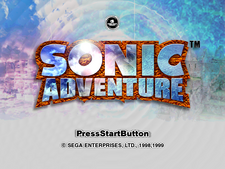
The title screen of Sonic Adventure.
Three thousand years ago, the Chaos Emeralds and the Master Emerald were kept at the Altar of Emerald near the territory of the Knuckles Clan. A peaceful echidna named Tikal, daughter of Chief Pachacamac, befriended the Chao that lived there and their guardian, the water god Chaos. When Pachacamac sought to expand his clan's territory, he attempted to steal the Chaos Emeralds to use their power against his rivals. Despite Tikal and the Chao's resistance, Pachacamac ordered his soldiers to attack, leading to the injury of many Chao. This enraged Chaos, who transformed into Perfect Chaos and destroyed all of the echidnas, except for Tikal, who sealed herself and Chaos within the Master Emerald. The resulting magic transformed the shrine's surroundings into Angel Island.
In the present day, Doctor Eggman discovers the Knuckles Clan's ancient shrine while constructing his Final Egg base in the Mystic Ruins' jungle. There, he deciphers stone tablets that tell the legend of Chaos. The doctor, seeking to exploit the beast's powers for his own gain, plans to subdue and use him to destroy Station Square, paving the way to build his own city, Eggmanland, on its ruins. He also creates the Egg Carrier, a versatile aerial fortress, and the E-100 Series, an army of elite Badniks, to aid in realizing this goal.[6][7][8]
Adventure's narrative spans six main stories, which star each of the playable characters and happen concurrently. A seventh story is unlocked upon beating the other six and is set in the game's climax.
Sonic[]

Sonic arriving to face off against Chaos after Station Square's police force retreats.
Under a shimmering night sky, Sonic the Hedgehog, freshly returned from a training journey, races through Station Square, only to hear a blaring siren. He discovers the police surrounding Chaos, whose liquid body renders their weapons ineffective. The hedgehog defeats Chaos, but the creature escapes through a drain. Meanwhile, Eggman watches from afar, confident in Chaos' supremacy.[6][9]
The next day, Sonic finds his friend Tails crashed on the beach with a damaged plane. As the two head to Tails' Lab, the fox explains he was testing a Chaos Emerald's power. However, when they near the workshop, Eggman ambushes them and steals the Emerald. The doctor reveals his plan to use Chaos, whom he has transformed into Chaos 1, and Sonic and Tails resolve to secure the remaining Emeralds to prevent Eggman's plan.

They soon recover two Emeralds, one in Windy Valley and another in Casinopolis, but Eggman ambushes them and steals one. They find another Emerald in Icecap, but run into Knuckles, who believes Sonic has stolen some of the Master Emerald's shards. During their fight, Sonic drops his Chaos Emeralds, allowing Eggman to take them and transform Chaos into Chaos 4. The trio defeats the creature, and the doctor retreats in his Egg Carrier. Sonic and Tails pursue him in the Tornado, only for the plane to be shot down.

Sonic and Tails landing on the Egg Carrier.
Sonic finds himself alone in Station Square in the aftermath. There, he runs into Amy, who asks him to protect Birdie, a bird she is looking after. Sonic declines but loses track of her. Amy is then kidnapped by E-100 ZERO, prompting Sonic to follow them to the Mystic Ruins, where they retreat into the Egg Carrier. He later reunites with Tails in the Tornado 2, and the duo boards Eggman's battleship. After navigating its changing structure, they find Amy, who has befriended E-102 Gamma. Sonic spares Gamma after Amy's plead. The Egg Carrier then begins to malfunction, and Sonic has Tails escort Amy to safety while he confronts Eggman.
Sonic soon finds Eggman, who has given two more Chaos Emeralds to Chaos, transforming him into Chaos 6. The hedgehog defeats him with the help of Big the Cat, who is searching for his friend Froggy inside the creature. Sonic then attempts to catch Eggman, but misses and plummets back to the Mystic Ruins, where he is lured into the shrine of Knuckles's race by a floating orb. There, he finds a mural with Perfect Chaos and is transported back in time. He witnesses the destruction of the Altar of Emerald and the sealing of Chaos before being returned to the present. Sonic then chases Eggman to the Final Egg, defeats him in a final showdown with the Egg Viper, and reunites with Tails.
Tails[]
While Sonic is away on his journey, Miles "Tails" Prower has immersed himself in his workshop at the Mystic Ruins.[9] He tests a prototype Chaos Emerald-powered biplane above Station Square. Initially, the plane performs well, but soon the Emerald's power overwhelms it, causing a malfunction.[10] After a precarious flight through the city, the plane crashes on an island in the nearby emerald sea. Fortunately, Sonic witnesses the crash and comes to help.
Back in Station Square, Tails explains that he was testing the Chaos Emerald's power. He then convinces Sonic to visit his workshop. Upon arrival, however, they are confronted by Doctor Eggman, who steals the Emerald. He then reveals Chaos, transforms him into Chaos 1, and unveils his plan. After the villains retreat, Tails and Sonic set out to find the remaining Emeralds to thwart the doctor's plan.
The duo recovers two Chaos Emeralds: one in Windy Valley and another in Casinopolis, but Eggman ambushes them with sleeping gas and steals one Emerald. The next day, they head to Icecap to find another Emerald but encounter Knuckles. Due to a misunderstanding, Knuckles and Tails fight, allowing Eggman to snatch the Emeralds and transform Chaos into Chaos 4. The heroes defeat the creature, but the doctor escapes in his Egg Carrier. Tails and Sonic give chase in the Tornado, but their plane is shot down.
Tails crash-lands in the Mystic Ruins. Reflecting on his first meeting with Sonic, he decides to continue without him and searches for another Chaos Emerald. He finds one, but it is swallowed by Froggy, Big the Cat's friend. After a chase through Sand Hill, Tails catches the frog and gets the Emerald, only to be transported back in time and meet Tikal. After returning to the present, Tails is briefly shocked by Big, but returns to his task.
Using the Chaos Emerald, Tails finishes his new invention, the Tornado 2. He reunites with Sonic at the Red Mountain, and together they pursue the Egg Carrier. After a wayward landing, they navigate through the battleship, eventually finding Eggman confronting Amy and Birdie. Eggman grabs Birdie and takes a Chaos Emerald from his pendant, then summons E-102 Gamma to deal with the heroes. Amy convinces Tails to spare Gamma, trusting him as her friend. With the Egg Carrier losing altitude, Sonic has the fox take the pink hedgehog to safety while he goes after Eggman.
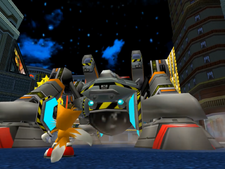
Tails facing Doctor Eggman's Egg Walker.
As the Egg Carrier crashes into the ocean, Tails and Amy return to Station Square. The fox spots a devastated Eggman trying to launch a missile to destroy the city. The missile turns out to be a dud, so Eggman goes to detonate it manually. Tails races against him and deactivates it. The doctor, furious, deploys his Egg Walker and threatens Tails. The fox confronts and defeats Eggman. The citizens cheer for Tails as the villain retreats. On his way back to the Mystic Ruins, Tails meets Sonic, having conquered his fears and proven himself a hero.
Knuckles[]
|
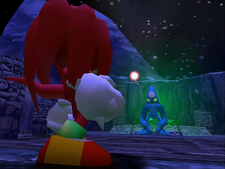
Knuckles faces off against Chaos after the latter emerges from the broken Master Emerald.
On a stormy night, Doctor Eggman's Egg Carrier nears Angel Island, where Knuckles the Echidna is meditating. A strike shatters the Master Emerald and summons Chaos. Knuckles tries to fight him but is overpowered, and Angel Island starts to sink. The echidna sets out to recover the Master Emerald's scattered shards.
In Station Square, Knuckles finds six shards and is transported back in time, where he overhears Tikal trying to stop her father, Pachacamac, from invading foreign land. Returning to the present, he confronts Eggman, who falsely claims Sonic is also after the shards. Knuckles fights the hedgehog at the Mystic Ruins, allowing the doctor to steal Sonic's Chaos Emeralds and use them to transform Chaos into Chaos 4. After reconciling with Sonic and Tails, Knuckles helps them defeat Chaos 4 and parts ways with them.
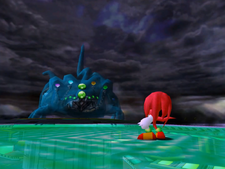
Continuing his quest, Knuckles finds three more shards in the shrine of his race, but is sent back to the past in the aftermath a second time. He witnesses Tikal’s futile attempt to persuade Chaos and the Chao to leave the Altar of Emerald before her father's attack. Returning to the present, the still incomplete Master Emerald indicates that the final few shards are onboard the Egg Carrier, which Knuckles infiltrates after following E-102 Gamma into the Final Egg. After securing the last shards, he is transported back to the past again, where the Altar of Emerald is in ruins. Following a brief interaction with Tikal, who rushes to the Master Emerald, Knuckles returns to the present and battles Chaos 6. After a long fight, the creature retreats, and Knuckles takes the Chaos Emeralds with him. He returns to Angel Island and restores the Master Emerald, lifting the island back into the sky.
Amy[]
|

Amy fleeing from ZERO with Birdie.
Living in Station Square, Amy Rose is bored with her mundane life. Her routine is disrupted when Doctor Eggman's Egg Carrier appears in the city. A small bird falls from the vessel, and Amy notices E-100 ZERO, one of Eggman's robots, chasing it. She hides from the robot in a burger shop and vows to protect the bird, whom she names Birdie. She later finds Sonic and asks him to look after Birdie, but he refuses. Amy follows him to Twinkle Park, where ZERO catches up. She and Birdie are caught and imprisoned onboard the Egg Carrier.

Amy confronting Gamma at the Prison Hall.
In the Egg Carrier's Prison Hall, E-102 Gamma demands Amy hand over Birdie, but she refuses. She appeals to Gamma, who, moved by Birdie's presence, helps them escape. The robot warns Amy that they are approaching the Mystic Ruins. The hedgehog offers Gamma her friendship before leaving. Amy and Birdie escape the Prison Hall by winning a Hedgehog Hammer game, and navigate the Hot Shelter while avoiding ZERO. Amy is then transported to the past, where she sees Tikal meeting the Chao at the Altar of Emerald. Returning to the present, she and Birdie are cornered by Eggman, who takes a Chaos Emerald from the bird's penchant. Sonic and Tails arrive, and Amy has them spare Gamma after he is dispatched by the doctor. Sonic goes to confront Eggman, while Tails takes Amy and Birdie to Station Square as the Egg Carrier crashes into the ocean.
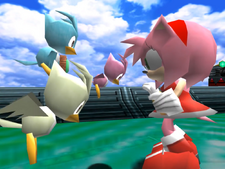
Amy bidding farewells to Birdie and his family.
Back in Station Square, Amy reflects on her dependence on Sonic and decides to help Birdie find his siblings.[note 1] They scour the Final Egg but have no success in finding his family. The duo returns to the abandoned Egg Carrier, which is now floating in the sea. There, Birdie reunites with his siblings but is striked by ZERO. Infuriated, Amy destroys the robot and bids farewell to the birds. Determined to gain Sonic's respect, Amy sets off with her newfound resolve.
Gamma[]

Gamma with Eggman upon his activation.
Coming online at the Final Egg, E-102 Gamma, the second robot in the E-100 Series, is met by his creator Doctor Eggman, who orders the robot to obey him and tests his abilities in the shooting range. Gamma later proves himself by defeating his "big brother", E-101 Beta, despite Eggman's initial doubts. Impressed, the doctor allows Gamma to join his crew on the Egg Carrier.
Eggman then tasks Gamma and his "brothers", E-103 Delta, E-104 Epsilon, and E-105 Zeta, to capture a frog named Froggy, who possesses a unique tail. Gamma tracks Froggy to Emerald Coast, snatching him from his owner, Big the Cat. However, the robot is suddenly transported to the past by Tikal, where he learns about Chaos and the Chao at the Altar of Emerald. Returning to the Egg Carrier, Gamma presents Froggy to Eggman, earning praise while the other E-100 robots are discarded.

Gamma watching Beta being horrendously remodeled. This was one of many events that led to him abandoning Eggman.
Next, Eggman sends Gamma to the Prison Hall to retrieve Birdie, who is imprisoned with Amy. On his way, Gamma witnesses Beta undergoing a terrifying remodulation by accident, leaving a mark on him. In the Prison Hall, Amy refuses to hand over Birdie and appeals to Gamma's sympathy. Moved by Birdie's presence, Gamma frees the prisoners, warning them of upcoming danger. The robot then receives an upgrade and is ordered to eliminate Sonic and Tails on the Egg Carrier's rear deck. After a fight with Sonic, Amy intervenes and urges Gamma to leave Eggman.
As the Egg Carrier crashes, Gamma's previous experiences lead him to view his creator as an enemy. He then embarks on a quest to "rescue" his fellow E-100 robots by destroying them and liberating the Animals inside. He tracks and destroys Delta at Windy Valley, Epsilon at the Red Mountain, and Zeta at the Hot Shelter onboard the abandoned Egg Carrier. There, Gamma confronts E-101 Mark II in a fierce battle, defeating his "brother" but sustaining fatal damage in the process. As Gamma collapses and explodes, a cream-colored bird is freed from Beta and joins the pink bird released from Gamma. The two birds, who are Birdie's siblings, fly off together.
Big[]
|

On a peaceful night at the Mystic Ruins' jungle, Big the Cat is sleeping in his hut with his pet and best friend, Froggy. Suddenly, a light in the sky falls nearby, causing a small tremor. Froggy goes out to investigate and swallows a mysterious puddle of water. When the cat wakes up, he is surprised to see that Froggy has grown a tail. The frog then eats Big's Chaos Emerald and runs away. Concerned and confused, Big sets out to find his friend.
Big's chase leads him to Station Square, where he catches Froggy in Twinkle Park, but the frog escapes. His search continues in the Mystic Ruins, where he finds Froggy in Icecap, only for him to escape once more. Big eventually sees Tails with Froggy in the Mystic Ruins Station Area, but the fox accidentally lets go of the frog, who escapes yet again. Big then tracks Froggy to the Emerald Coast, where E-102 Gamma snatches the amphibian and flees.
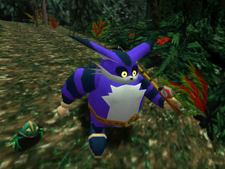
Following Gamma, Big boards the Egg Carrier and locates Froggy at the Hot Shelter. He rescues his friend, but they are suddenly transported to the past by Tikal, where Big learns about Chaos and the Chao at the Altar of Emerald. Returning to the present, the duo attempts to escape the Egg Carrier. They encounter Chaos 4 and Doctor Eggman, who explains that Froggy is possessed by Chaos' tail. The creature transforms into Chaos 6 using the Chaos Emeralds, and Froggy jumps into Chaos, losing his tail in the process. Sonic arrives and helps the cat defeat Chaos, freeing Froggy in the process. Big thanks the hedgehog and uses the Tornado 2 to leave the falling airship. Big and Froggy safely return home and celebrate their reunion by dancing and fishing together.
Super Sonic[]
The last story, unlocked by beating all six previous storylines, begins with the damaged Tornado 2 next to Big's house, still holding its Chaos Emerald. Soon after, Angel Island falls back into the ocean. Doctor Eggman, moving through the Mystic Ruins' jungle, spots Chaos, who has survived the crash of the Egg Carrier. Meanwhile, Knuckles is at the Altar of Emerald, puzzled by the island's fall despite the Master Emerald being intact. He deduces that the six Chaos Emeralds he brought have something to do with it and plans to seek Sonic's advice. The echidna then finds an unconscious Eggman, who mumbles about Chaos but cannot elaborate. As Knuckles approaches, Chaos is also nearby.
At the Mystic Ruins Station Area, Sonic is relaxing when Tails informs him that Angel Island has fallen again. They rush to the Altar of Emerald and find Knuckles and Eggman unconscious. Chaos, having betrayed the doctor, has stolen the six Chaos Emeralds and attacked the two. Furious, Eggman sets off to get revenge, while Knuckles warns Sonic that Chaos is a formidable foe who must not obtain the final Emerald. The hedgehog is then transported to the past by Tikal, where he witnesses the Altar of Emerald being raided by Pachacamac, leading to Chaos turning into Perfect Chaos and rampaging in fury. Tikal uses her prayer to the Master Emerald to stop Chaos.
|
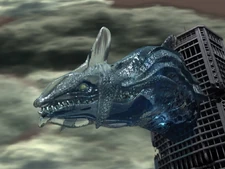
Perfect Chaos rampaging in Station Square.
Back in the present, Sonic and Tails head to the Tornado 2 to find the last Chaos Emerald. However, Chaos, in the form of a water pillar, takes the Emerald and leaves. Station Square then suffers a devastating flood caused by Perfect Chaos, who destroys the city. Eggman approaches in the Egg Carrier 2, but it is easily destroyed by Perfect Chaos, leaving Eggman defeated. Tikal appears and explains that she sealed Chaos in the Master Emerald, but he is filled with rage and anguish. Sonic disagrees with resealing him, stating it will not change Chaos' feelings. Tails, Amy, Knuckles, Big, and Birdie, the pink bird from Gamma, gather the unpowered Chaos Emeralds and give them to Sonic. Tails explains that the hedgehog can harness their "real" power with positive energy. Sonic transforms into Super Sonic and battles Perfect Chaos, eventually defeating and calming him. Chaos reverts to his normal form and is surrounded by Chao. Tikal explains that the Chao have lived peacefully with humans for generations.
With harmony restored, Tikal departs with Chaos into heaven.[11] Sonic then sees Eggman retreat and leaves in search of new adventures.
Characters[]
| Image | Character | Biography |
|---|---|---|

|
Sonic the Hedgehog | He's the world's fastest, hypersonic hedgehog! With a strong love for freedom, the only thing Sonic hates is oppression. Despite his short temper, deep down he's a really nice guy who is 100% committed to helping those in trouble whenever and wherever he can. Sonic's adventure begins as he is returning home from a long journey...[9] |

|
Miles "Tails" Prower |
This sweet-natured fox is a natural born mechanic with the unique ability to fly high in the sky using his two special tails. |

|
Knuckles the Echidna | Knuckles is one wild and powerful spiny anteater. Although blessed with an honest, straight-up personality, he often lacks flexibility. With his powerful arms, he can glide through the air to attack and land some serious punches. Guardian of the Master Emerald for as long as he can remember, one seemingly normal day his world is shattered and a new adventure begins...[13] |
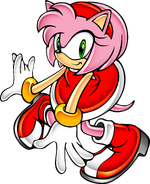
|
Amy Rose |
Always bright and cheerful, Amy is the self-appointed girlfriend of Sonic. Possessing a strong competitive streak, she is second to none when in control of her Piko Piko Hammer. |
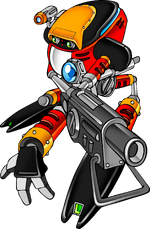
|
E-102 Gamma | Created by the evil Dr. Robotnik, E-102 Gamma is an E-100 series gunner robot. Shortly after his "birth", Gamma must pass a test that will enable him to join an elite unit of robots. His destiny then takes a drastic turn when he meets a certain frog with an unusual tail...[15] |

|
Big the Cat |
This giant cat is one laid-back and easy going fellow who loves to fish and is never without his favorite rod and lure. |

|
Dr. Robotnik | Yes, just as we all feared, the mad scientist is back and more ruthless than ever before. In the past, Sonic and friends have managed to ruin all his evil plans, but are those days over?! A new battle has begun and this time, Dr. Robotnik ("Eggman" to Sonic and his pals) has at long last figured out how to harness the massive ancient power of the 7 Chaos Emeralds to destroy the world![17] |

|
Chaos | This mysterious liquefied life-form that had been trapped in the Master Emerald was released by Dr. Robotnik to do his evil bidding. Chaos grows bigger and more powerful with each emerald that Dr. Robotnik adds to him. What will happen to the world if Dr. Robotnik manages to add all seven Chaos Emeralds...?[17] |
Gameplay[]
Sonic Adventure is a 3D third-person action platformer video game, with some parts taken from earlier Sonic games. The player controls Sonic, Tails, Knuckles, Amy, Gamma, and Big, each with their own gameplay and point of view of the story. Upon starting for the first time, only Sonic's story is available from the start but as the player progresses throughout the game, they'll unlock the other characters' stories, thereby making them available for play. After completing all these stories, the player will be able to play as Super Sonic in the game's final battle with Perfect Chaos. The game is divided up into two types of levels: Action Stages and Adventure Fields. The division of Action Stages and Adventure Fields are a serious departure from all previous Sonic games.
Sonic Adventure features many Action Stages that can be played with certain characters. Unlike past games however, the Action Stages are not automatically acceded for the player; instead, the playable character must find their entrance points in the Adventure Fields of the game. Adventure Fields are non-linear game stages, generally designed for (light) puzzle solving, exploration and plot advancement. They contain very few items (enemies, Rings, etc.). Every Adventure Field links to the other Adventure Fields and a Chao Garden. They also have four Emblems each. They are each packed with various Level Up Items for different characters. As the player progresses with the story, more areas will be opened in the Adventure Fields for the player to explore.
All Action Stages of Sonic Adventure have Rings scattered in them. While one of the most common elements in the game, Rings are very important as they serve as the playable character's main method of protection against attacks; should the playable character be hit by an obstacle or enemy, they will survive at the cost of losing all their Rings. However, if the player is damaged without having any Rings on them, they will lose a life and will have to restart the current Action Stage from either the beginning or at the last Star Post. Falling into bottomless pits, drowning underwater or getting crushed also counts as a loss of life. If all lives are lost, it is a Game Over.
Sonic Adventure also features Sub Games. Sub Games are minigames based on Action Stages. When the player completes a Sub Game in Story Mode, they unlock it on the Sub Game menu located on Trial Mode. For some Sub Games, the player can use any character, but some of them require the use of the character(s) from Story Mode. The player can get two Emblems from each Sub Game, from achieving high scores. The second emblem requires a much higher score than the first. The scores appear at the end of a Sub Game. The player cannot get two Emblems per character but can use any to get one Emblem (if it allows more than one character).
Also introduced in Sonic Adventure is the Chao. Chao primarily inhabit the Chao Gardens as a sort of intelligent virtual pet for the player to raise, an "evolution" of the A-life system from Nights into Dreams Chao can be taken with the player by downloading the minigame Chao Adventure to their VMU and can also be used in Chao Races.
Character-specific gameplays[]
Sonic[]
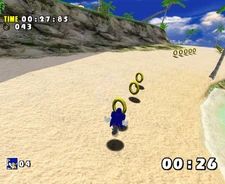
Sonic in Emerald Coast, the first Action Stage in his story.
Sonic the Hedgehog's gameplay is, for the most part, the same as that from earlier Sonic games, as it involves high-speed gameplay. The fastest of the playable characters, Sonic can perform an Spin Dash to gain instant speed in seconds and use the Homing Attack to target an obstacle or enemy and attack them.
In addition to his normal moves, Sonic gains extra abilities as he collects Level Up Items. For example, collecting the Light Speed Shoes allows him to perform the Light Speed Dash. Conversely, he can collect the Ancient Light in order to perform the Light Speed Attack. Then there is the Crystal Ring that allows him to charge the two aforementioned moves in less time.
Tails[]
Miles "Tails" Prower's gameplay is, for the most part, similar to Sonic's, except that he is slightly slower. To compensate for this, he can fly for some time and perform the Tail Swipe to attack his enemies. While not being able to perform the Spin Dash, Tails can still curl into a ball while running, which also vastly increases his momentum on linear downhill slopes.
Tails' Action Stages are races against specific opponents. To win these Action Stages, Tails must get to the goal before his opponent does. If his opponent reaches the goal first, the young fox cub will have to restart the current Action Stage at the cost of a life.
Tails can gain better abilities by collecting Level Up Items throughout his story. By collecting the Rhythm Badge, he can perform the Rapid Tails Attack, and the Jet Anklet allows him to fly faster than normal.
Knuckles[]
Knuckles the Echidna's gameplay is similar to that from past games. Moving slower than Sonic and Tails, he can glide to reach platforms in the distance with ease. In addition, colliding with a wall while gliding will allow him to climb that wall. He can also throw punches to attack nearby enemies and objects. Much like Tails, Knuckles is also able to curl into ball while running.
Knuckles' Action Stages have him collecting three Emerald Shards hidden in each Action Stage. Once he has collected all three Emerald Shards, he will have cleared the Action Stage.
Knuckles' abilities can be upgraded by collecting Level Up Items. He can perform a Maximum Heat Knuckles Attack by collecting the Fighting Gloves. He can also collect the Shovel Claws to perform the dig technique.
Amy[]
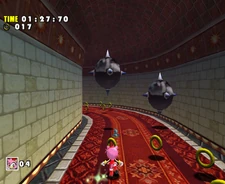
Amy in Twinkle Park, the first Action Stage in her story.
Amy Rose's gameplay is different from that of the other characters. Running slowly and making small jumps instead of the Spin Jump, she can use her Piko Piko Hammer to perform a Hammer Attack, which is her main method of attack. While in midair, she can also perform a Jump Attack as a variation of the Spin Attack. Additionally, while running, she can perform the Hammer Jump to launch herself into the air.
Amy's Action Stages have her having to run away of E-100 ZERO, who seeks to catch her. The player needs to complete some puzzles while avoiding ZERO's attacks in the Action Stages. The pink hedgehog's Action Stages will be cleared by grabbing a local Goal Balloon.
Amy's moves can be upgraded by collecting Level Up Items. For example, she can collect the Warrior Feather to perform the Spin Hammer Attack. Then there is the Long Hammer, which increases her moves' attack range.
Gamma[]
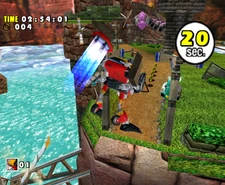
Gamma in Windy Valley, the third Action Stage in his story.
E-102 Gamma's gameplay is different from that of other characters. He can use the Laser Gun to target his enemies and destroy them with the Homing Missile Launch.
Gamma's Action Stages have him destroying Badniks to free the Animals inside them. Unlike other characters, Gamma has a time limit to clear his Action Stages; should that time run out, the player will lose a life, or get a Game Over if they have run out of lives. Destroying Badniks gives the player some additional time. Once all the Badniks have been destroyed, the Action Stage will end.
Gamma's abilities will be upgraded as he collects Level Up Items. For example, he can collect the Jet Booster to perform the hover. Then there is the Laser Blaster that allows him to perform more powerful Homing Missile Launches.
Big[]
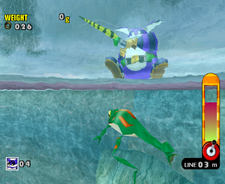
Big in Icecap, the second Action Stage in his story.
Big the Cat has a unique gameplay style. For combat, he can use his Fishing Rod to perform a Lure Attack, which he can use to attack enemies in front of him.
Big's Action Stages have him using his Fishing Rod to catch Froggy. However, the player can also catch fish to gain extra points. The larger the fish is, the more points the player will receive. Once a fish or Froggy bites the lure, the player will have to reel it in. Once the player has caught Froggy, the Action Stage will end. If Big's line breaks, he'll have to restart that current Action Stage at the cost of a life.
Big can collect Level Up Items to upgrade his abilities. For example, the Life Belt allows him to float into the water unless the player wants to dive in it. The player can also collect the Power Rod, which is a more powerful version of the Fishing Rod.
Scoring system[]
Controls[]
General[]
| Button formation | Movement |
|---|---|
| Move | |
| Change camera angle | |
| L/R | Pan the camera |
| Pick up/Set down item | |
| Shake item/Cuddle Chao | |
| Jump > |
Throw item |
| START | Pause |
Character specific[]
| Button formation | |
|---|---|
| Spin Jump | |
| Homing Attack | |
| Spin Dash |
| Button formation | |
|---|---|
| Spin Jump | |
| Propeller Flight | |
| Tails Attack/Rapid Tails Attack | |
| Move + |
Spin Attack |
| Button formation | |
|---|---|
| Jump | |
| Gliding Jump | |
| Punch Attack | |
| Dig (requires Shovel Claw) | |
| Move + |
Spin Attack |
| Button formation | |
|---|---|
| Jump | |
| Hammer Attack | |
| Move + |
Hammer Jump |
| Spinning Hammer Attack (requires Warrior Feather) |
| Button formation | |
|---|---|
| Jump | |
| Carry heavy item / Cast rod / Lure Attack |
| Button formation | |
|---|---|
| Jump | |
| Hover (requires Jet Booster) | |
| Laser Gun/Homing Missile Launch |
Objects[]
Items[]
- Air bubble
- Cart pass (first appearance)
- Chao Egg (first appearance)
- Chaos Emerald
- Doll (first appearance)
- Emblem (first appearance)
- Emerald Shard
- Employee ID Card (first appearance)
- Item Box
- 5 Rings (first appearance)
- 10 Rings
- Extra Life
- High-Speed Shoes
- Invincibility
- Magnetic Shield
- Random Rings (first appearance)
- Shield
- Smart Bomb
- Key Stone (first appearance)
- Gold statue (first appearance)
- Ice Stone (first appearance)
- Silver statue (first appearance)
- Wind Stone (first appearance)
- Level Up Item (first appearance)
- Ancient Light (first appearance)
- Crystal Ring (first appearance)
- Fighting Gloves (first appearance)
- Jet Anklet (first appearance)
- Jet Booster (first appearance)
- Laser Blaster (first appearance)
- Life Belt (first appearance)
- Light Speed Shoes (first appearance)
- Long Hammer (first appearance)
- Lure (first appearance)
- Power Rod (first appearance)
- Rhythm Badge (first appearance)
- Shovel Claw (first appearance)
- Warrior Feather (first appearance)
- Ring
- Sandboard (first appearance)
- Snowboard
- Sonic Token (first appearance)
Gimmicks and obstacles[]
- Bumper
- Bumper Car
- Cannon
- Capsule
- Conveyor Belt
- Crank
- Dash panel
- Dash Ring
- Drum Can
- Explosion Trap
- Fan
- Flame dart
- Flipper
- Fountain
- Goal Balloon
- Hanging Bell
- Helicopter
- Hint Box
- Hint Orb
- Icicle
- Iron ball
- Jump Panel (plate)
- Jump Panel (ramp)
- Jump Ramp
- Laser field
- Lit Panel
- Mirror
- Monkey Detonation Switch
- Orca
- Point Marker
- Power cube
- Rocket
- Slot machine
- Spiked bar
- Spring
- Spring Catapult
- Switch
- Teleporter
- Wide spring
- Wind Path
- Zip Line
Characters[]
Playable characters[]
- Amy Rose
- Big the Cat (first appearance)
- E-102 Gamma (first appearance)
- Knuckles the Echidna
- Miles "Tails" Prower
- Sonic the Hedgehog
Non-playable characters[]
- Birdie (first appearance)
- Chao (first appearance)
- Chaos (first appearance)
- Chaos 1 (first appearance)
- Chaos 2 (first appearance)
- Chaos 4 (first appearance)
- Chaos 6 (first appearance)
- Perfect Chaos (first appearance)
- Dr. Eggman
- E-Series (first appearance)
- E-100 Series (first appearance)
- E-100 ZERO (first appearance)
- E-101 Beta (first appearance)
- E-101 Beta Mk. II (first appearance)
- E-103 Delta (first appearance)
- E-104 Epsilon (first appearance)
- E-105 Zeta (first appearance)
- E-100 Series (first appearance)
- Froggy (first appearance)
- Grandma (mentioned)
- Mr. Know-It-All (first appearance)
- Nights (cameo)
- Pachacamac (first appearance)
- Tikal (first appearance)
- Mecha Sonic Mk. III (first appearance)
- Animals
- Deer (first appearance)
- Elephant (first appearance)
- Gorilla (first appearance)
- Kangaroo (first appearance)
- Koala (first appearance)
- Lion (first appearance)
- Mole (first appearance)
- Parrot (first appearance)
- Peacock (first appearance)
- Penguin (first appearance)
- Rabbit (first appearance)
- Robin
- Seal (first appearance)
- Sea Otter (first appearance)
- Skunk (first appearance)
Enemies[]
- Beat (first appearance)
- Bladed Spinner (first appearance)
- Boa-Boa (first appearance)
- Buyoon (first appearance)
- Cart Kiki (first appearance)
- Cop Speeder (first appearance)
- Egg Keeper (first appearance)
- Electro Spinner (first appearance)
- Fighter Aircraft A (first appearance)
- Fighter Aircraft B (first appearance)
- Gola (first appearance)
- Ice Ball (first appearance)
- Icecap's unnamed aircraft (first appearance)
- Kiki (first appearance)
- Leon (first appearance)
- Mechanical fish (first appearance)
- Pirate (first appearance)
- Rhinotank (first appearance)
- Sky Deck's unnamed jet fighter (first appearance)
- Satellite (first appearance)
- Spiky Spinner
- Sweeper (first appearance)
Levels[]
Action Stages[]
- Emerald Coast (Sonic/Big/Gamma)
- Windy Valley (Sonic/Tails/Gamma)
- Casinopolis (Sonic/Tails/Knuckles)
- Icecap (Sonic/Tails/Big)
- Twinkle Park (Big/Sonic/Amy)
- Speed Highway (Knuckles/Sonic/Tails)
- Red Mountain (Knuckles/Sonic/Gamma)
- Sky Deck (Sonic/Tails/Knuckles)
- Hot Shelter (Amy/Big/Gamma)
- Lost World (Sonic/Knuckles)
- Final Egg (Gamma/Amy/Sonic)
Adventure Fields[]
Chao Gardens[]
Sub Games[]
- Boss
- Hedgehog Hammer (Amy)
- Sky Chase (Sonic/Tails)
- Sand Hill (Tails/Sonic)
- Twinkle Circuit
Bosses[]
| No. | Sonic | Tails | Knuckles | Amy | Big | Gamma | Super Sonic |
|---|---|---|---|---|---|---|---|
| 1. | Chaos 0 | Egg Hornet | Chaos 2 | ZERO | Chaos 6 | Beta | Perfect Chaos |
| 2. | Egg Hornet | Knuckles | Sonic | N/A | Sonic | N/A | |
| 3. | Knuckles | Chaos 4 | Delta | ||||
| 4. | Chaos 4 | Egg Carrier | Chaos 6 | Epsilon | |||
| 5. | Egg Carrier | Gamma | N/A | Zeta | |||
| 6. | Gamma | Egg Walker | E-101mkII | ||||
| 7. | Chaos 6 | N/A | N/A | ||||
| 8. | Egg Viper | ||||||
Development[]
Background[]
In the early-to-mid 1990s, Sega was amongst the largest video game developers at the time, namely due to the success they gained with the Sonic the Hedgehog series and its eponymous protagonist. By this time, the fifth generation of video games was introducing new capabilities never before seen with 3D graphics and other innovations in the industry. In November 1994, Sega released their new console, the Saturn, which was successful in Japanese markets but was overshadowed by Sony's PlayStation in the United States and Europe, which was much more powerful and easier to develop games on.[18]
After the release of Sonic & Knuckles in October 1994, series co-creator and producer Yuji Naka was getting tired of developing Sonic games and returned to Japan amid tensions between the Japanese and American members of the Sega Technical Institute.[18] The release of the Saturn was the perfect opportunity for him to follow a new direction, and he and the rest of the Sonic Team began work on an original title, Nights into Dreams.[19] While Naka intended to finish the game in one year and move on to making a Sonic title, Nights would take two years to develop.[18]
Meanwhile, Sega of Japan began work on a new Sonic game with an isometric view: Sonic 3D Blast. To manage the project, they turned to British developer Traveller's Tales. The title would be released for the Mega Drive and the Saturn to lukewarm reviews. Meanwhile, with the release of Sonic Spinball in 1993, the American members of the STI wanted to make a 16-bit game based on the Sonic the Hedgehog television series. Their request was denied at first, but they were allowed to work on the project, named Sonic Mars on the Sega 32X. Development soon shifted to the Saturn as Sonic X-treme, planned as the first 3D entry in the franchise. However, multiple factors led to the work being canceled, leaving the Sonic series without a major title for the console. In 1997, Traveller's Tales released Sonic R, a racing spin-off game for the Saturn, to mixed reviews.[18]
Many have credited the Saturn's failure to the lack of a Sonic mainline game for the system.[20] It was also noted that, by mid-1997, the series had been "shuffled into the background" and that Sonic was "already retro" only six years after his debut, with director Takashi Iizuka feeling was not only because of that, but also due to the character himself having felt very safe, boring and conservative, as opposed to the fresh image he had when he debuted.[21]
Conception[]
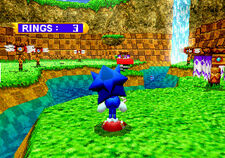
The Sonic World in Sonic Jam, one of Yuji Naka's experiments to make a 3D Sonic game for the Sega Saturn.
After finishing Nights into Dreams, Yuji Naka thought of the concept of a 3D Sonic game around August 1996, and began experimenting to see how Sonic would work on a 3D environment; one of these attempts included the Sonic World seen in Sonic Jam.[22] Around the same time, Takashi Iizuka, who had also developed Nights into Dreams, proposed to Naka that they should develop a role-playing game (RPG) Sonic game.[23][24]
Development of Sonic Adventure began in April 1997, around the same time Sonic R's development was wrapping up in the United Kingdom,[25] with the name "Project Sonic".[26] It had a team of twenty members: seven programmers, ten artists and three game designers; the game was originally developed to be released on the Sega Saturn.[22] When they made a prototype of the game on that console, however, they found out that the Saturn was only able to use manipulated sprites to present a display that represented polygons. Then, Sega informed Naka of the Dreamcast, which he believed could help the team create the best Sonic game possible; as such, they moved development to the new console.[21][22][27][19] The timing of the new game with the new hardware turned out to be rather fortunate, as Sonic Team had influence in the Dreamcast to match its vision of Sonic Adventure; since the console was in its planning stages of development, they were able to send requests to the hardware team about the memory they needed to run the game.[21] The development team focused on graphics and high resolution for this game, with Naka reflecting that they had pushed the Dreamcast "as far as [they could] at present".[28] Approaching the end of the project, the crew expanded to having over sixty people working on the title,[22] with a peak of 130 developers for around two months.[29]
Design[]

Sonic Team at Tikal's temple.
As a launching game for the Dreamcast, Sonic Team needed to show off what the console was capable of doing in an appealing way to the public.[21] In order to achieve a more natural, realistic feel to the exotic levels like ruins and jungles, the core members of the Sonic Team traveled to the Americas in November and December 1997. The team's journey began in the northern part of the peninsula in the Chichen Itza, from there the team traveled southward along the Eastern side of the Peninsula where they also visited Cancun, Tulum and finally Tikal. The team then left the peninsula traveling down through Central America, into South America, Peru, where they visited Cuzco, Machu Picchu and then Ica. The Chichen Itza and Tikal provided the aesthetics concept of the shrine of Knuckles's race, Chaos and the serpents drawing on the walls of the temple;[30][31] Cancun and Tulum provided the concept of Emerald Coast;[32][33] Cuzco provided the Altar of Emerald;[34] Machu Picchu provided the design of Windy Valley;[35] and Ica provided the the aesthetics for Sand Hill.[36] However, the trip was not all fun and games, the team having unexpected encounters with giant spiders, snakes, and Yuji Naka caught a fever at 39 degrees Celsius (102 degrees Farinheit) before arriving at South America.[26] At the end of it all, the team returned to Japan in one piece, full of enthusiasm to create the game. During the trip, the developers photographed the actual ruins, then processed that data, and used them in-game as textures to create a sense of realism and enliven the feeling of adventure.[37]

Comparison between the early gameplay footage and the final release.
According to Naka, the biggest hurdle the team faced when making the game was that they did not have any actual hardware, which was completed only two months before the game's 1998 release.[25] Another challenge he encountered when developing Sonic Adventure was the creation of the levels; since Sonic was a very fast character, he spent a lot of time creating giant maps that he would not have needed to create had he developed a game for another franchise like Mario.[22] This forced him and the team to adopt a completely different approach of level design and make solutions that were not needed in 2D games. In the beginning, they would build a model of the stages, play through it, scrap it, make the whole level from scratch, and repeat until they felt satisfied with the result.[21] Because of this, certain levels such as Lost World and Windy Valley were rebuilt dozens of times.[24] In addition, the developers ditched the traditional method of creating levels on paper, and instead adopted a method of designing 3D maps using 3D tools from the beginning and making corrections when testing the levels.[38] Even with the ability to make as many requests for the hardware as they could, Sonic Team faced several technical difficulties: at the time, Sonic's height marked down at one meter, but having a character at that height run very fast required the stages to be several kilometers long and the data to get to very high sized for a single level. As such, the developers had to split single stages into various smaller maps that would allow the game to fit the allowed memory size.[21] Naka also thought of reusing these same maps for the other playable characters to add variety.[22]
Gameplay mechanics[]
Sonic Team prioritized making the player feel exhilarated by the speed throughout Sonic Adventure. They additionally made the camera in such a way that the players would not get lost while playing; in other words, they tried to make it change its angle depending on the terrain and always show the direction the player has to go. Furthermore, the camera was made to produce dynamic action, such as looking downward when in high places to create a feeling of nervousness, and from the side whenever the character would run through loops and such.[37]
The developers felt it would be a waste of time to just have Sonic run through the various stages and finish them in no time. As such, they thought of ways they could leverage their assets effectively; from that, the remaining five playable characters' abilities were born. Since these had unique playstyles, Iizuka figured they should each have their own stories and goals to accomplish, so he thought it would be interesting to have an overarching story that was told from each of the characters' perspectives. The first two characters, apart from Sonic himself, were Tails and Knuckles. The team decided to have the former's gameplay adopt portions of the hedgehog's stages and turn them into one-to-one races. As for the echidna, they designed his game style to contrast with that of Sonic. Since the red character's original bio said he was a treasure hunter, Iizuka instantly got the idea of having his levels revolve around treasure hunting in a 3D space. Amy, who debuted in Sonic the Hedgehog CD, also became playable. The developers chose a less combat-oriented gameplay style despite her Piko Piko Hammer; since the aforementioned characters all engaged in "aggressive behavior" as the core fun factor of the game, Iizuka thought of giving Amy a play style that was more about the thrills of technical gameplay, hiding from pursuers and running away when an enemy popped up.[21] During development many wrote into Sega, requesting a new character that would shoot enemies, but they thought that giving the characters a gun would be odd.[28] The developers, however, had the idea of making one of Dr. Eggman's Badniks be a playable character, giving place to the shooting gameplay in the creation of E-102 Gamma.[21] The most unusual inclusion, Big the Cat, came from Sonic Team wanting a character that would break up the action from all the other characters.[28] They decided to present the players with fishing gameplay, since they had water in the game.[21]
In order to join up the stages in Sonic Adventure, the developers implemented hub worlds in the form of Adventure Fields. These were created so that the player could be drawn deeper into the world, with progression being marked by the collection of power-ups and the unlocking of new areas through newfound abilities and advancing in the story, an idea that Iizuka conceptualized with inspiration from The Legend of Zelda.[21] There were also many discussions on the cutscenes in the game in Japanese; some wanted to have Sonic only speak English with subtitles, while others wanted him to speak in "his own language". In the end, it was decided to just have the characters speak Japanese.[26]
Characters[]
The developers had problems representing the existing characters in 3D; for instance, Sonic's "big" head obscured the rest of his "small" body. As such, it soon became clear that the hedgehog's basic design had to be changed to make him taller and alter his head-to-body proportions.[39] The feeling that the cast's designs were "dated"[21] and that Sonic was being perceived as a "cute guy",[26] combined with concerns at Sega that the characters were feeling more "Japanese" than "Western" or "American",[39] allowed the team to give them a refresh. At the time, other "retro" games like Pac-Man and Space Invaders were achieving popularity again by popping out with indie music and "urban street" fashion. According to art director Kazuyuki Hoshino, this made the team want to make Sonic appeal to this type of subculture.[21]
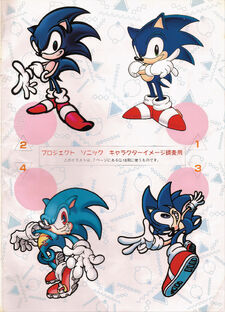
Proposed redesigns of Sonic, clockwise from top left: by Satoshi Okano, the promotional artist for Sonic Jam; Yuji Uekawa, the character designer of Sonic R; Naoto Ohshima, one of Sonic's original creators; and Takumi Miyake, the designer of Knuckles' Chaotix.
An internal contest was held at Sega to determine who would be in charge of the character redesigns. The participants included Yuji Uekawa (Sonic R character designer), Satoshi Okano (Sonic Jam promotional art), Naoto Oshima (Sonic's original creator) and Takumi Miyake (designer for Knuckles' Chaotix). Uekawa was the winner, though he would take some inspiration from the other entries for his final design.[40][41] Using Akira Toriyama's style of deformation and line art style, Susumu Matsushita's airbrush art, and the cartoon designs of Walt Disney and Looney Tunes as inspiration, he began examining what had made Sonic's original design so popular; he concluded that the character was iconic due to his eye shape and long quills, which made him recognizable just by looking at his silhouette. As such, for the redesign, Uekawa prioritized the lines of his quills, always showing their curvature, regardless of Sonic's position.[39] The character was given longer limbs and twisted styles,[21] and to further express his dynamism and strength, Uekawa drew him using a calligraphic line expression used in many comics.[39] Iizuka subsequently noted that the new design was more suitable for 3D than the original and more compact one, which was meant to be seen from the side.[42][43] After Sonic's design was finished, Uekawa was tasked with redesigning the rest of the Sonic cast to have the same design and style; as the basic design was already locked in, he had no problems in adjusting the other characters.[39] Though the designs were made in 2D, it later paid off as it helped translate the characters into 3D, and the style was made to represent the fashion trends at the time and to fit with club music, which Hoshino himself was really into at the time.[21]
Aside from the redesigns, the developers made even more changes to the characters. One such decision was to controversially introduce the name "Dr. Eggman" to the Western world, which used the name "Dr. Robotnik" instead. Simultaneously, the nickname "Tails" replaced the more traditional "Miles" extensively used in Japan. Iizuka stated in retrospect that this was done to unify the names across regions since the franchise was regaining its lost popularity.[21]
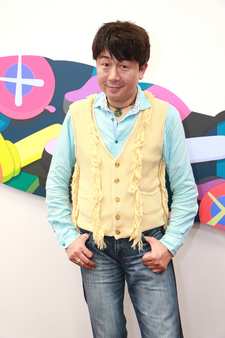
Jun'ichi Kanemaru (pictured here in 2016) became Sonic's voice actor in Japanese beginning with Sonic Adventure.
As of 1998, the Sonic cast never really had a voice; the only times the characters spoke were in the various animated media at the time and a few arcade games, but Sonic Adventure became the first major title in which all of the cast was voiced. At first, people like Iizuka were reluctant to give Sonic a voice, and various meetings were held where the team would decide the voice actor for the character. However, believing that voices would be essential for the future of the series, Iizuka spent a very long time researching for a voice actor for the character; during this time, he listened to countless demo tapes of samples of various voice actors. Rather than status, Iizuka was looking for a voice actor that would fit Sonic's personality perfectly. With Sonic also being more popular overseas than in Japan, it was intended to have Sonic naturally speak in English from time to time. As such, it was very difficult to decide on a proper voice, because the trait was such that the character would speak in English interchangeably, so Iizuka was concerned about what intonation he would use when he spoke in English, amongst various other things. Meanwhile, while dubbing for a Japanese dub of the American sitcom Growing Pains, voice actor and singer Jun'ichi Kanemaru was approached by a Sega official who was looking for someone to voice Sonic. Iizuka was convinced that Kanemaru was the perfect fit for Sonic upon hearing the demo tape of his voice, and thus he became the voice actor of the character ever since.[44][45]
Sonic Team also wanted an enemy that was completely separate from Dr. Eggman, and also something that could only be created on the Dreamcast. Wanting something liquid and transparent, the character of Chaos was thought up. Presenting the original concept art and idea to Naka, Chaos was approved on the spot, his role in the game cemented.[46][21]
Soundtrack[]
The sound director and lead music composer of Sonic Adventure was Jun Senoue, who had already composed tracks for Sonic the Hedgehog 3 and the Sega Mega Drive version of Sonic 3D Blast. Back then, there were two types of music in Sonic games: the tracks in the Mega Drive games and the "house-dance" music in Sonic the Hedgehog CD and Sonic R. Since this game was a big turning point for the franchise, being the first fully 3D title and the first one in a new console, the team decided to change the music genre as well.[47] After extensive trial and error, they chose to have rock music as the game's soundtrack in order to synchronize with the atmosphere on the screen. Each of the tracks in the game were not pre-recorded, but rather live tracks that were made to demonstrate the potential of the Dreamcast.[38] Senoue wanted to retain the classic Sonic soundtrack whilst adding a harder edge to it; various of the tracks from previous games he had composed were reused in Sonic Adventure. These included the jingles from Sonic the Hedgehog 3 and various of the tracks in Sonic 3D Blast.[21]
The game's main theme is entitled "Open Your Heart" and is performed by Crush 40 (under the name "Sons of the Angels"), making Sonic Adventure the first Sonic game that had the band perform the soundtrack. The soundtrack of Sonic Adventure has been distributed through four albums:
- Sonic Adventure: Songs With Attitude Vocal Mini-Album contains the five character themes and the main theme ("It Doesn't Matter", "My Sweet Passion", "Lazy Days (Livin' in Paradise)", "Believe In Myself", "Unknown from M.E.", and "Open Your Heart").
- Sonic Adventure Original Sound Track (Digi-Log Conversation) contains all of the music tracks of the game.
- Sonic Adventure Remix contains remixed character theme songs in addition to the five character themes and the main theme from Sonic Adventure: Songs With Attitude Vocal Mini Album.
- Sonic Adventure Original Soundtrack 20th Anniversary Edition contains an abridged number of the music tracks from Sonic Adventure Original Sound Track (Digi-Log Conversation) and along with some other game soundtracks in the Sonic the Hedgehog series, this soundtrack album was released in order to commemorate the 20th anniversary of the Sonic the Hedgehog franchise.
Promotional[]
Sega made it a top priority to keep Sonic Adventure a secret until shortly before its release. Despite these efforts, screenshots were leaked onto the Internet in mid-1998. Yuji Naka presented the game to Edge in mid-August.[28]
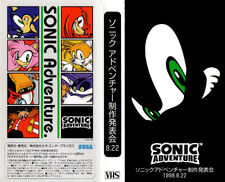
The case of the Sonic Adventure Production Presentation VHS.
To promote Sonic Adventure, a Japanese website was set up that would reveal details about Sonic Team's trip through Latin America, as well as the logo of the game and Sonic's new design. Additionally, on Saturday, 22 August 1998, an event known as the Sonic Adventure Production Presentation (SONIC Adventure 制作発表会[48] Sonikku Adobenchā Seisaku Happyōkai?) was hosted at Tokyo International Forum Hall A in Yūrakuchō, first from 10:00 to 11:00 and then from 13:30 to 14:30. The presentation, featuring Naka, showed off various parts of the game, including its plot, characters, development, stages, and other things such as the Chao and Chao Adventure. The admission was free, with no tickets being required, and visitors could purchase Sonic-related souvenirs. For those who could not make it to the event, it was also available on VHS.[37][48] In addition, a pamplet, named Sonic Adventure Tokyo International Forum Unveiling Booklet, alongside a pin set, were available.[49]
Prior to the worldwide release of the game, Sega made an exclusive deal with Hollywood Video to allow customers to rent a Dreamcast with a non-retail version of the game, Sonic Adventure: Limited Edition.[50][51] The promotion began in July 1999 and took place at 1055 Hollywood Video stores across the United States. Additionally, DiC Entertainment's Sonic Underground was commisioned to help promote Sonic Adventure.[52]
Release[]
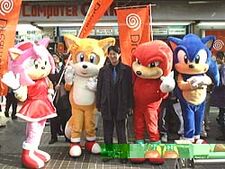
From left to right: Amy, Tails, Yuji Naka, Knuckles, and Sonic promoting Sonic Adventure during its release.
Sonic Adventure was first released on 23 December 1998 in Japan. On that day, various murals of Sonic were painted across Shibuya in Tokyo.[53] Additionally, Yuji Naka and some other people disguised as Sonic, Tails, Knuckles and Amy appeared to support dealers in Shinjuku, Ikebukuro, and Akihabara.[54]
After the game's release in Japan, Sega and Sonic Team believed the game was not as finished as they would have liked it to be.[citation needed] In February 1999, Sega's vice president Tadahiko Hirose announced that Sonic Adventure would be released along with Virtua Fighter 3tb and Sega Rally 2 as launch titles for the Dreamcast's international release.[55] In June 1999, Sega announced that Sonic Adventure would be one of the five titles in the Dreamcast's "Masterpiece Collection".[56] The North American version of the game includes Japanese and English-language audio tracks, as well as Japanese, English, Spanish, French and German subtitles.[57] Online gameplay and downloadable content were also added for the localization.[58] The game was released worldwide in late 1999; in Japan, the updated version was re-released under the name Sonic Adventure International (ソニックアドベンチャー インターナショナル Sonikku Adobenchā Intānashonaru?).
Reception[]
| Reception | |
|---|---|
| Aggregate scores | |
| Aggregator | Score |
| GameRankings | 86.51%[59] |
| Review scores | |
| Publication | Score |
| AllGame | |
| Computer and Video Games | |
| Edge | 8/10[61] |
| Famitsu | 38/40[62] |
| GameRevolution | |
| GameSpot | 9.2/10 |
| IGN | 8.6/10[63] |
Sonic Adventure received generally favorable reviews from critics, and was acclaimed by reviewers for being the first fully 3D Sonic platformer, with some going so far as to call it one of the greatest video games of all time, although future ports and remakes, such as Sonic Adventure DX: Director's Cut, have had more mixed reception. The current GameRankings average ranking is 86.51 out of 100.[59] It became one of the few Sega All-Stars games.
The Japanese video game magazine Famitsu gave the game a score of 38/40.[62] Although criticized for its camera system, framerate issues, and fishing stages with Big, the game was still highly praised for retaining the fast and enjoyable gameplay that Sonic was known for in 2D as well as the game's graphics, multiple character storylines, and soundtrack. Brandon Justice of IGN rated the game an 8.6 out of 10, criticizing various glitches and voice acting while praising the game's visuals and gameplay.[63] As of August 2006, Sonic Adventure has sold over 2.5 million units worldwide, making it the best-selling Dreamcast game.[64] This includes one million sold in the United States.[5]
At the time of its release, Sonic Adventure was acclaimed by the Arcade magazine as a "quantum leap forward" in aesthetics and visual detail in video games,[65] estimated by Hyper to exceed that which was possible on high-end PCs.[66]Computer and Video Games stated shortly after release that "Sonic Adventure is one of the best games ever made" and marveled that "many things you thought were impossible to see and experience in computer games are now here."[60]Edge's preview stated that graphical features like an "amazingly detailed cityscape" showed off the Dreamcast's potential, comparing it to Super Mario 64's role for the Nintendo 64, and exclaimed that "as a showcase of what the machine can do, Sonic Adventure is perfect."[61] Speculation arose that the game could save the Dreamcast,[65][67] which had not sold well so far by the end of 1998,[65] or even re-establish Sega as the dominant console manufacturer after the relatively unsuccessful Sega Saturn.[68]
Cast[]
| Role | English dub actor | Japanese voice actor |
|---|---|---|
| Sonic the Hedgehog | Ryan Drummond | Jun'ichi Kanemaru |
| Miles "Tails" Prower | Corey Bringas | Kazuki Hayashi |
| Knuckles the Echidna | Michael McGaharn | Nobutoshi Canna |
| Amy Rose | Jennifer Douillard | Taeko Kawata |
| Big the Cat | Jon St. John | Shun Yashiro |
| Tikal | Elara Distler | Kaori Asoh |
| Default menu voice | ||
| Dr. Eggman | Deem Bristow | Chikao Ōtsuka |
| E-102 Gamma | Steve Broadie | Jōji Nakata |
| Pachacamac | Tōru Ōkawa | |
| Station Square announcer | Lani Minella | Kaho Kōda |
| Egg Carrier announcer | ||
| Mystic Ruins announcer | Steve Broadie | Nobutoshi Canna |
| Police Captain | ||
| E-103 Delta | ||
| E-104 Epsilon | ||
| E-105 Zeta | ||
| Chao | Tomoko Sasaki | |
| Sonic Team original voice (Reused audio from NiGHTS into Dreams) | Lynn Eve Harris | |
| Additional voices | Lani Minella | Nobutoshi Canna |
| Steve Broadie | Kaho Kōda | |
Pre-releases[]
| Image | Name | Platform | Description |
|---|---|---|---|

|
Sonic Adventure: Limited Edition | Dreamcast | Released in the United States in July 1999, being available for rent for two months. |
Re-releases[]
| Image | Name | Platform | Description |
|---|---|---|---|

|
Sonic Adventure DX: Director's Cut | Nintendo GameCube PC |
Released in 2003 and 2004. |

|
Sonic Adventure | Xbox 360 PlayStation 3 PC (Steam) |
Digitally released in 2010 and early 2011. |
Downloadable content[]
When Sonic Adventure was released on the Dreamcast, Sega regularly uploaded content onto the in-game site that would unlock already programmed, yet hidden, data. Sega had many downloads for Sonic Adventure as it was a launch title for Dreamcast as well as the Dreamcast's most popular game (selling 2.5 million copies as of June 2006). Most of these downloads were events and challenges that mostly took place in Station Square. These events were to celebrate an actual event or for competitions that were hosted by Sega.
International[]
Dreamcast Launch Party[]
|
One of the first things made available was the Dreamcast launch party in Station Square. Around the city, banners and balloons featuring the Dreamcast emblem and logo were set up and would thank people for supporting Sega and Sonic Team, as well as pointing out that there was plenty more in store. While the posters and language varied, mainly because of the different swirl color, it is generally the same Dreamcast posters and balloons that thank the player on behalf of Sega and Sonic Team when jumped at.
Halloween Party[]
|
From 19 October to 28 December 1999, Sega released Halloween decorations for Twinkle Park. Scattered around the level, graffiti has been tagged all over the walls and floors wishing the players a Happy Halloween, while Jack-o-Lanterns in witch's clothing danced around. "Trick or Treat" would occasionally come up while walking on the graffiti. Station Square also would have posters advertising Twinkle Park's Halloween party.
Christmas Party[]
|
From 17 to 28 December 1999, this download placed Christmas trees outside of Station Square and the town center. Jumping at them will give a festive message as well as changing Station Square's theme to the Acapella version of "Dreams, Dreams" from Christmas Nights. Heading to the other parts of Station Square will reset its theme back to its usual theme.
The Christmas Party download has a flaw that prevents the player from finishing Sonic's story mode if installed. The largest Christmas Tree found in Station Square occupies the same space as the ID card that opens the way to Speed Highway. When the card appears, the Christmas Tree will not allow the player to get close enough to actually pick it up.
Y2K Celebration[]
|
With the year 2000 on the horizon, Sonic Adventure was given a Millennium Ring that floats around Station Square and two in several stages. Upon touching one, the player is given a message wishing them a happy new millennium, while being asked to support Sonic during that time. As this occurs, Palmtree Panic's Japanese present theme plays in celebration. There are also various posters around Station Square with the following messages: "Knuckles digging through 2K!" "Tails smiles through 2K!" and "Sonic runs through 2K!"
Samba GP[]
A new track was made available for download, titled "Samba GP." The track was released to celebrate the arrival of Samba de Amigo, although oddly enough, the track had little to do with Samba de Amigo aside from the fact that it uses an instrumental version of Sonic R's "Super Sonic Racing", which is a playable song in Samba de Amigo. Upon completing the track, the player could save their score and upload it online to compare against others. Worth noting is the fact that this was the final update to the game that included any actual changes to the main game itself. Afterwards, Sega began to focus on Time Attack contests within the regular game.
Voice Packs[]
Files that allowed different character voices in the Menus. Files were released for Sonic, Tails, Knuckles, Amy, Big, Gamma, Dr. Eggman and Tikal.
United States[]
AT&T/ODCM[]
AT&T and Official Dreamcast Magazine teamed up to release three Time Attack contests. One involved blazing through Speed Highway as Sonic, the next involving Knuckles collecting treasures in the Mystic Ruins, and the final one involving Tails surfing through ten specially marked gates in Sand Hill. Prizes were awarded to the quickest scores. A total of fifteen winners would be awarded one-year long subscriptions to the Official Dreamcast Magazine, nineteen winners would be awarded a Dreamcast game, and five would receive an AT&T Premium Package for a whole year. It is likely that the grand prize received all three. This contest ran from 29 October to 19 November 1999.
Europe[]
Reebok DMX Competition[]
Contestants from across Europe could download a specially designed version of Emerald Coast. Gamers were required to retrieve five pairs of hidden Reebok DMX trainers, which Dr. Eggman had stolen from Sonic's wardrobe, while still competing for the fastest completion time. Times were then uploaded to Sega's servers so that contestants could gauge their rating. The winners would then be notified via e-mail and their names published on the Sonic Home Page and Dreamarena at the end of the competition. The prizes included a personalized Dreamcast pod and £1,000 worth of Reebok sportswear. Neil Riddaway won the challenge by finishing in 46.09 seconds.
Emerald Coast cannot be completed if this pack is loaded. Upon reaching the tunnel to transport Sonic to the second section, a signboard will prevent progress and touching the sign will tell the player they need to delete the DLC file in order to play the rest of Emerald Coast.
Japan[]
Christmas Trees in Station Square[]
Released sometime around the Christmas season of 1998, this DLC scattered Christmas trees around Station Square. Touching them would reveal a Japanese message and play various Christmas songs, depending on what tree the player touches.
Kadomatsu[]
Released in the closing days of 1998 (along with a bugfix version released shortly after it was posted), this DLC added Kadomatsu decorations around Station Square. Touching them would show a message in Japanese and play some traditional Japanese folk music, with the message and music varying similar to the Christmas 1998 DLC. This pack was thought to have been lost for over twenty years due to no player preserving the associated files but it was rediscovered on a memory unit purchased from Japan in late 2019.[69]
Hedgehog Hide and Seek[]
Released on 12 February 1999, Famitsu held a contest where players had to track down five pictures of actual hedgehogs that were placed around Station Square. To start the game, one must jump to the red sphere in front of the train station. Once all pictures are found, the player would then have to go into the station and jump at the light blue sphere to finish the game.
Yukawa Senmu QUO MiniGame[]
The Yukawa Senmu QUO MiniGame DLC consisted of the player running around Station Square and Mystic Ruins to try and collect six "Mr. Yukawa" cards (three in each area) in the shortest time. This was a promotion from 22 January to 22 February 1999, where 50 winners would get a ¥500 QUO card with a picture of Hidekazu Yukawa, the Sega manager on the Dreamcast box. The QUO card is a universal pre-paid card that can be used in over 10000 convenience stores and other locations in Japan.
Jewel Chao[]
Special Chao that were available in the Black Market on the Sonic Adventure website. Only three were available for Sonic Adventure and only in Japan. They were the Emerald Jewel Chao, Sapphire Jewel Chao, and Ruby Jewel Chao.
Voice Pack (International)[]
A special version of the Voice Packs was released for Sonic Adventure International. The main difference between the two is that this one includes every voice file compiled in one file. The various voices are activated randomly in the menus.
Adaptations[]
Comics[]
Archie Comics produced a tie-in story arc that began in Sonic the Hedgehog #79 and concluded in Sonic the Hedgehog #84, with the thirteenth Sonic Super Special, "Sonic Adventure," taking place in between.
Sonic the Comic also included a ten-issue loose adaptation of the game, which was notably the final story arc ever produced for the series.
Sonic X[]
The Sonic X anime series included a six-episode adaptation of the game's events between "Pure Chaos" and "Flood Fight", known as the "Chaos Saga". This adaptation was mostly faithful to the game's plot, with the Japanese version even being a word-for-word adaptation at some points. However, parts were written in for characters that did not appear in Sonic Adventure such as Christopher Thorndyke and Cream the Rabbit.
Trivia[]
- This is the first ever modern Sonic game.
- According to Takashi Iizuka, Sonic Adventure was the hardest Sonic game to develop as of 2022.[11]
- Sonic Adventure is the first Sonic game to feature downloadable content, as the Dreamcast was the first ever video game console to have online capabilities out of the box. DLC ranged from celebratory holiday decorations in the Adventure Fields and a few levels, such as on Christmas and Halloween, to national ranking contests and the addition of the Chao Black Market.
- The game has sold over 2.5 million copies worldwide, making it the best-selling Dreamcast game.[70]
- In the beginning of Super Sonic's story, even with English voices activated, Sonic will yawn in his Japanese voice.
- In the original Dreamcast version of the game, if one were to insert the disc into a PC, special wallpapers hidden on the disk will be available for download. There is also a list of main console Sonic games prior to the release of Sonic Adventure (although Sonic the Hedgehog CD is absent). It reads:
- SERIES TITLE:
- SONIC the Hedgehog, 1991
- SONIC the Hedgehog 2, 1992
- SONIC the Hedgehog 3, 1994
- SONIC and KNUCKLES, 1994
- SONIC JAM, 1997
- SONIC Adventure (for Japan), 1998
- The screenshots from the ending are from the initial Japanese release in all Dreamcast versions and the GameCube enhanced port in further re-releases.
- Not counting the Sonic World in Sonic Jam, this is the first Sonic game to feature a hub world.
- This game is represented in Sonic Generations. Speed Highway reappears as the first stage of the Dreamcast Era in the home version, while Emerald Coast appears as the first stage in the portable version. Also, Perfect Chaos appears as the Gate Boss of the Dreamcast Era in the home version.
- This is the first Sonic game to have a different level entrance screen style. The other is Sonic Unleashed.
- Some tracks in the WMA files and sound test are not heard at points in the game where the name suggests it should play.
- The Egg Carrier was meant to have a different track for when it had landed in the sea.
- This track, however, is used during the cutscene when Gamma finds E-101 Beta as E-101 MKLL.
- Amy was meant to have a track named "Amy: Hurry Up", that supposedly was meant to have played when she was being chased by ZERO.
- This track was instead used during the cutscene in Tails' Story when Eggman launches the Giant Missile on Station Square. (Since Amy was in the beginning of this cutscene, it could be named after Amy telling Tails to hurry up)
- Many prototype images from the Dreamcast were re-used for the promotion of Sonic Adventure DX: Director's Cut.
- The Egg Carrier was meant to have a different track for when it had landed in the sea.
- Ryan Drummond said in an interview this is his favorite Sonic game.
- Hot Shelter is the only stage where Sonic is not playable.
- Sonic Adventure was listed in the book 1001 Video Games You Must Play Before You Die, along with the original Sonic the Hedgehog and its sequel.[71]
- During the credits on the Dreamcast version of the game, there are screenshots with a number of differences from normal gameplay. Screenshots with considerable changes (aside from lighting changes) include:
- In the image where Sonic sees Tails crash at the beginning of his story, the skybox is stretched.
- In the image where the orca chases Sonic, there are no Dash Panels.
- In the image of the tornado course in Sonic's version of Windy Valley, there is much more debris flying around than in normal gameplay.
- In Casinopolis' image, the vault is filled with 269 Rings.
- The image of Eggman ambushing Sonic/Tails is set at the wrong time of day (this is the same time of day used for this scene in the AutoDemo of the game).
- In the image of Tails in Icecap, Tails rides a different snowboard.
- The image depicting the aftermath of the defeat of the Egg Walker is set at the wrong time of day.
- In the image of Tails in Speed Highway, the helicopter is present in the background.
- This image is considerably different from the cutscenes in the game. The best-matching cutscene is the one from before Amy enters Eggman's base, but that one is shown from a different angle. Amy also does not wear that expression and birdie is missing from the image.
- This image depicts Gamma from when he is sent to the past. While this does happen in his story, Gamma is in the Mystic Ruins temple in the image, an area he cannot enter.
- The image of Gamma batting E-103 Delta depicts the event in an arena much bigger than the one seen in gameplay.
- The time of day in some of Big's images does not match those in gameplay.
- In this image, Super Sonic is never seen from this angle.
- During Super Sonic's ending, Knuckles is seen without his Shovel Claw and Tails is seen without his Rhythm Badge, despite both being mandatory to obtain in order to complete their stories and unlock Super Sonic's.
- Knuckles is the only character who appears with Level Up Items in his images (even before he is permitted to add them).
- During Amy's flashbacks, some of the backgrounds seen come from unused layouts of some of the Action Stages, like the early Windy Valley and Sky Deck.
- There are also some changes in Gamma's flashbacks, like differences in lightening. Also when Gamma remembers Beta being rebuilt, Beta's eyes are black instead of red, the front bars have different textures and the background is very different.
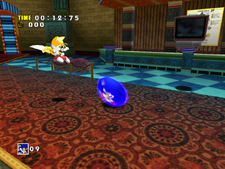
- In Sonic's story, whenever Tails is near Sonic while the latter is doing one of his attacks in gameplay, Tails gets damaged despite having no impact on Sonic's progression during the stages.
- Knuckles' theme played the least in his story compared to any other characters' stories, with it only being heard one time. He is also the only character whose theme is not played at the beginning and the end of his story.
- According to the Sonic Adventure manual in North America, Doctor Eggman is a feminist. However this is a translation error.
Videos[]
Notes[]
- ↑ Birdie's siblings are incorrectly identified as his parents in the English release.
References[]
- ↑ 1.0 1.1 ドリームキャスト (Japanese). Sonic Channel. Sega. Retrieved on 12 March 2022.
- ↑ SONIC ADVENTURE DEBUTS ON SEGA DREAMCAST WITH BREAKTHROUGH INTERNET GAMEPLAY VIA DREAMCAST NETWORK. Sega (9 September 1999). Archived from the original on 19 April 2000. Retrieved on 9 July 2024.
- ↑ SEGA EUROPE UNVEILS MORE THAN FORTY TITLES FOR DREAMCAST BY CHRISTMAS. Sega. Archived from the original on 28 November 1999. Retrieved on 9 July 2024.
- ↑ DREAMCAST REVIEWS & GAME LIST. Future Gamez (16 July 2001). Archived from the original on 28 June 2001.
- ↑ 5.0 5.1 US Platinum Videogame Chart. The Magic Box (27 December 2007). Archived from the original on 10 January 2016.
- ↑ 6.0 6.1 "Story". Sonic Adventure Tokyo International Forum Unveiling Booklet. 22 August 1998. p. 5.
- ↑ "All Star Cast". Sonic Adventure Tokyo International Forum Unveiling Booklet. 22 August 1998. p. 9.
- ↑ Sonic Team (23 December 1998). Sonic Adventure. Dreamcast. Sega. Cutscene: Cutscene 6. "Doctor Eggman: Ooooh, yes! It's just as the stone tablets predicted. Ha ha ha ha ha! His [Chaos'] strength increases every time I feed him a Chaos Emerald! With all 7 Emeralds in him, he'll be invincible! And work for me! Together, we'll destroy Station Square! And on its ruins, I will build Robotnikland, the ultimate city! Where I will rule it all!"
- ↑ 9.0 9.1 9.2 Sonic Adventure (Dreamcast) United States instruction booklet, pg. 18.
- ↑ ZedArchive (10 April 2022). Sonic Adventure Production Presentation At Tokyo International Forum (1998) [ENGLISH CC] (Japanese). YouTube. Retrieved on 7 October 2022.
- ↑ 11.0 11.1 Game Informer (12 July 2022). Sonic Frontiers: 123 Rapid-Fire Questions With Takashi Iizuka. YouTube. Retrieved on 13 July 2022.
- ↑ Sonic Adventure (Dreamcast) United States instruction booklet, pg. 20.
- ↑ Sonic Adventure (Dreamcast) United States instruction booklet, pg. 22.
- ↑ Sonic Adventure (Dreamcast) United States instruction booklet, pg. 24.
- ↑ Sonic Adventure (Dreamcast) United States instruction booklet, pg. 26.
- ↑ Sonic Adventure (Dreamcast) United States instruction booklet, pg. 28.
- ↑ 17.0 17.1 Sonic Adventure (Dreamcast) United States instruction booklet, pg. 31.
- ↑ 18.0 18.1 18.2 18.3 "History". The History of Sonic the Hedgehog. Les Editions Pix'n Love. 6 September 2013. pp. 54-65. ISBN 978-1-926778-96-9.
- ↑ 19.0 19.1 Towell, Justin (23 June 2012). Super-rare 1990 Sonic The Hedgehog prototype is missing. GamesRadar. Retrieved on 4 March 2014. "The reason why there wasn't a Sonic game on Saturn was really because we were concentrating on NiGHTS. We were also working on Sonic Adventure--that was originally intended to be out on Saturn, but because Sega as a company was bringing out a new piece of hardware--the Dreamcast--we resorted to switching it over to the Dreamcast, which was the newest hardware at the time. So that's why there wasn't a Sonic game on Saturn. With regards to X-Treme, I'm not really sure on the exact details of why it was cut short, but from looking at how it was going, it wasn't looking very good from my perspective. So I felt relief when I heard it was cancelled."
- ↑ Maba, Ray (24 June 2016). 『ソニック・ザ・ヘッジホッグ』誕生・ヒット・新生の真実をソニックチームのレジェンドクリエイターが、25周年のいま明かす 秘蔵資料満載の永久保存版! (Japanese). Famitsu. Retrieved on 27 March 2023.
- ↑ 21.00 21.01 21.02 21.03 21.04 21.05 21.06 21.07 21.08 21.09 21.10 21.11 21.12 21.13 21.14 21.15 21.16 Retro Game staff (28 December 2018). "The Making Of: Sonic Adventure". Retro Gamer. Archived from the original.
- ↑ 22.0 22.1 22.2 22.3 22.4 22.5 "Sega Saturn Magazine Interview with Yuji Naka". Sega Saturn Magazine (36). 8 October 1998. Archived from the original.
- ↑ The Sonic Stadium (29 August 2015). Sonic Adventure DX - Director's Commentary (2004). YouTube.
- ↑ 24.0 24.1 Mott, Tony (2013). 1001 Video Games You Must Play Before You Die. New York, New York: Universe Publishing. p. 370. ISBN 978-0-7893-2090-2.
- ↑ 25.0 25.1 "Official Dreamcast Magazine USA Interview with Yuji Naka". Official Dreamcast Magazine USA. September 1999. Archived from the original.
- ↑ 26.0 26.1 26.2 26.3 "Interview: Yuji Naka". Sonic Adventure Tokyo International Forum Unveiling Booklet. 22 August 1998. p. 24-25.
- ↑ Barnholt, Ray . Yuji Naka Interview: Ivy the Kiwi and a Little Sega Time Traveling. 1Up.com. Retrieved on 4 March 2014.
- ↑ 28.0 28.1 28.2 28.3 "Sega Unveils Sonic Adventure". Edge: 6-7. October 1998.
- ↑ "Edge Interview with Yuji Naka". Edge (76). 1999. Archived from the original.
- ↑ Chichen Itza. Sonic CulT. Archived from the original on 25 July 2015.
- ↑ Tikal. Sonic CulT. Archived from the original on 25 July 2015.
- ↑ Cancun. Sonic CulT. Archived from the original on 25 July 2015.
- ↑ Tulum. Sonic CulT. Archived from the original on 25 July 2015.
- ↑ Cuzco. Sonic CulT. Archived from the original on 25 July 2015.
- ↑ Machu Picchu. Sonic CulT. Archived from the original on 25 July 2015.
- ↑ Ica. Sonic CulT. Archived from the original on 25 July 2015.
- ↑ 37.0 37.1 37.2 ZedArchive (10 April 2022). Sonic Adventure Production Presentation At Tokyo International Forum (1998) [ENGLISH CC] (Japanese). YouTube. Retrieved on 7 October 2022.
- ↑ 38.0 38.1 "Making of Sonic Adventure". Sonic Adventure Tokyo International Forum Unveiling Booklet. 22 August 1998. p. 18-19.
- ↑ 39.0 39.1 39.2 39.3 39.4 Cook & Becker (17 April 2017). How Sega moved Sonic from 2D to 3D. Polygon. Retrieved on 12 December 2022.
- ↑ Aitchison, Sean (28 April 2020). The Unsung Artist Who Defined the Look of Sonic the Hedgehog. Fanbyte. Archived from the original on 3 November 2020.
- ↑ Okano, Satoshi (11 August 2020). OKN/Satoshi Okano/岡野聡 on Twitter. Twitter. Archived from the original on 11 August 2020.
- ↑ Thomason, Steve (January 2007). "Birth of a Hedgehog". Nintendo Power (Future Publishing) (211): 72.
- ↑ Summer Of Sonic 2011 - Takashi Iizuka & Yuji Naka Q&A (18:20). YouTube (25 March 2012). Retrieved on 10 July 2014.
- ↑ 金丸さんの声を初めて聞いたときに「この人だ!」 (Japanese). Nicovideo.jp (6 October 2021). Retrieved on 26 March 2023.
- ↑ ソニック役でお馴染み、声優・金丸淳一さん声優30周年インタビュー (Japanese). Animate Times (21 March 2016). Retrieved on 26 March 2023.
- ↑ Sonic Adventure DX Director's Cut Commentary With Takashi Iizuka - Part 2. YouTube (6 May 2015). Retrieved on 28 September 2015.
- ↑ Sega . ソニックチャンネル/クリエイターズ インタビュー/007 前編:瀬上 純 (Japanese). Sonic Channel. Retrieved on 12 January 2023.
- ↑ 48.0 48.1 発表! ソニック制作発表会!! (Japanese). Sega (1998). Retrieved on 31 December 2022.
- ↑ 緊急速報!![発表会パンフレット+ピンズセットの通信販売も決定!!] (Japanese). Sega (1998). Retrieved on 31 December 2022.
- ↑ Sonic Adventure: Limited Edition Quick Look. IGN (15 July 1999). Retrieved on 21 August 2022.
- ↑ A Sit-down with Sonic Adventure: LE. IGN (16 July 1999). Retrieved on 21 August 2022.
- ↑ Lee, Patrick (30 September 2015). A hedgehog for all seasons: Our guide to 20 manic years of Sonic cartoons. AVClub. Retrieved on 30 December 2022.
- ↑ Sonic at Shibuya 12/1998 (Japanese). Sega (1998). Retrieved on 30 December 2022.
- ↑ Sonic Adventure is here! (Japanese). Sega (1998). Retrieved on 30 December 2022.
- ↑ Ohbuchi, Yutaka (2 February 1999). Sonic, VF3, Rally 2 lead US DC launch. GameSpot. Retrieved on 19 January 2013.
- ↑ IGN Staff (1 June 1999). Sega's New Challenge Conference '99 Report. IGN. Retrieved on 19 January 2013.
- ↑ Gantayat, Anoop (28 August 1999). Sonic Adventure US Shocker. IGN. Retrieved on 19 January 2013.
- ↑ Gantayat, Anoop (24 August 1999). Sonic Adventure: Internet Gaming!. IGN. Retrieved on 19 January 2013.
- ↑ 59.0 59.1 Sonic Adventure Reviews. GameRankings. Retrieved on 20 April 2013.
- ↑ 60.0 60.1 "SONIC: It's been a long time coming, but we've been very". Computer and Video Games (215): 60. October 1999.
- ↑ 61.0 61.1 "Sega Unveils Sonic Adventure". Edge: 6. October 1998.
- ↑ 62.0 62.1 GEIMIN.NET/週刊ファミ通クロスレビュープラチナ殿堂入りソフト一覧. Geimin.net. Retrieved on 15 April 2013.
- ↑ 63.0 63.1 Justice, Brandon (8 September 2009). Sonic Adventure Review. IGN. Retrieved on 17 September 2009.
- ↑ Boutros, Daniel (4 August 2006). A Detailed Cross-Examination of Yesterday and Today's Best-Selling Platform Games. Gamasutra. Retrieved on 8 December 2006.
- ↑ 65.0 65.1 65.2 "Sonic Adventure". Arcade (1): 23. December 1998.
- ↑ "Sonic Adventure". Hyper: 18. March 1999.
- ↑ "Sonic Adventure". Computer and Video Games (209): 20. April 1999.
- ↑ "Sonic Adventure". Computer and Video Games (209): 12. March 1999.
- ↑ Moopthehedgehog (8 November 2019). Sonic Adventure New Year's 1998 "Kadomatsu" DLC. DCEmulation forums. Archived from the original on 29 November 2020. Retrieved on 3 April 2021.
- ↑ Boutros, Daniel (4 August 2006). A Detailed Cross-Examination of Yesterday and Today's Best-Selling Platform Games. Gamasutra. Retrieved on 8 December 2006.
- ↑ 1001 Video Games You Must Play Before You Die. Listology.
External links[]
- Official website (Japanese)
- Sonic Adventure International website (Japanese)
V·T·E · {{Adventure 2 info}} · Category
| 1991–99 | Sonic the Hedgehog (1991) · Sonic the Hedgehog 2 (1992) · Sonic the Hedgehog CD (1993) · Sonic the Hedgehog 3 & Knuckles (1994) · Sonic Adventure (1998) | |
| 2000s | Sonic Adventure 2 (2001) · Sonic Heroes (2003) · Sonic the Hedgehog (2006) · Sonic Unleashed (2008) | |
| 2010s | Sonic the Hedgehog 4: Episode I (2010) · Sonic Colors (2010) · Sonic Generations (2011) · Sonic the Hedgehog 4: Episode II (2012) · Sonic Lost World (2013) · Sonic Mania (2017) · Sonic Forces (2017) | |
| 2020s | Sonic Colors: Ultimate (2021) · Sonic Frontiers (2022) · Sonic Superstars (2023) · Sonic X Shadow Generations (2024) · Untitled game (TBA) | |












